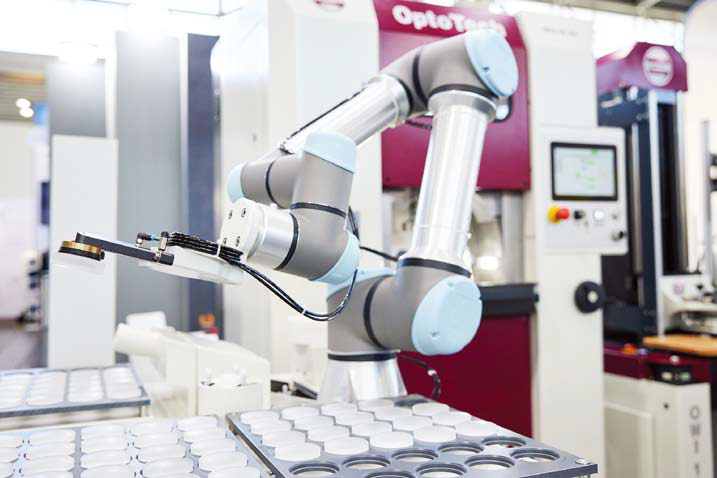
Artificial Intelligence (AI) is no longer a futuristic concept in photonics—it’s a present-day catalyst reshaping industrial production, medical diagnostics, materials processing, and environmental monitoring. At the recently concluded Laser World of Photonics 2025 in Munich, held alongside automatica, experts from across the globe gathered to explore how AI and photonics are converging to define the next frontier of technological innovation.
From Raw Data to Smart Manufacturing
One of the central takeaways from this year’s event is the maturing role of AI in turning raw sensor and process data into actionable insights. Whether it's optimising laser cutting parameters, improving optical system design, or accelerating R&D through digital twins and simulation, AI is enhancing photonics workflows across the board.
By analysing vast datasets in real time, AI-driven systems can now predict outcomes, correct errors, and even adapt process parameters on the fly. This brings manufacturers closer to fully automated, first-time-right production—a hallmark of Industry 4.0. Coupled with advancements in beam shaping and real-time imaging, photonics is enabling the closed-loop control systems necessary for self-learning laser machines.
Enhancing Microscopy and Material Analysis
Another area where AI is making waves is in high-resolution imaging and microscopy. Well-trained AI algorithms outperform traditional methods in sample recognition, focus optimisation, image segmentation, and 3D reconstruction. In laboratory and clinical settings, this leads to faster and more accurate diagnostics, especially when dealing with large-scale gigabyte or terabyte image datasets.
AI also plays a pivotal role in spectroscopy-based materials identification and plasma-based recycling, enabling trace-level detection and sorting of valuable materials. These capabilities open doors to single-origin recycling processes and more efficient resource recovery.
Medium Enterprises Leading the Charge
While global players like TRUMPF, ZEISS, and Coherent showcased cutting-edge AI applications, the event also highlighted the deep involvement of highly specialised SMEs. Companies such as Precitec and Scansonic are already integrating AI into laser welding, soldering, and real-time process monitoring systems.
Dr. Markus Kogel-Hollacher, Executive Director of AKL e.V. and R&D Head at Precitec Group, emphasised that AI enhances quality control in complex laser processes—especially where variables are difficult to quantify. "AI allows us to derive detailed physical characteristics such as weld seam strength or contact resistance directly from optical process data," he noted, citing use cases in battery and fuel cell production.
This shift from binary good/bad inspection to quantitative inline analytics represents a significant leap in manufacturing intelligence and efficiency.
Toward Smart Factories and Greener Data Centers
Photonics, enabled by AI, is also becoming central to the concept of smart, adaptive factories. Companies like 4D Photonics GmbH are integrating multispectral imaging systems with AI algorithms to facilitate multi-sensor process monitoring. These systems help detect root causes of defects, improve traceability, and reduce costly downtime.
Beyond manufacturing, photonics is beginning to address the energy demands of AI itself. Firms such as Q.ANT are developing photonic processors that use light instead of electrons for data processing. According to Managing Director Dr. Michael Förtsch, this could reduce energy consumption by a factor of 30 and increase computing density by up to 50 times.
This transition to optical computing not only enhances performance but also aligns with global sustainability goals. In his words, “A more scalable, more cost-effective, and more energy-efficient AI future is possible. Photonics is the way to get there.”
From Exhibition to Execution
At Laser World of Photonics 2025, the importance of practical implementation was emphasised through focused panels and application zones. The well-attended session, “From Theory to Practice: Implementing AI in Laser-Based Manufacturing Processes”, provided concrete examples of how AI is already optimising beam delivery, defect detection, and process control across industries.
Meanwhile, the “Photonics meets Robotics: AI Success Stories” crossover zone offered a look at how collaborative robots and photonic systems—both powered by AI—are reshaping the production floor.
Final Thoughts
Laser World of Photonics 2025 reinforced the message that AI is not simply augmenting photonics—it is transforming it. From optimising process parameters in real time to driving sustainable computing and enabling fully automated smart factories, AI is becoming a core enabler of the photonics industry's most ambitious goals.
The synergy between light and intelligence promises not only higher precision and productivity but also a path toward greener, more adaptable, and more resilient technologies.
As we move into the second half of the decade, one thing is certain: the future of photonics is intelligent—and AI is lighting the way.
About the LASER World of PHOTONICS The LASER World of PHOTONICS is the world’s leading platform for the laser and photonics industry. Europe’s largest World of Photonics Congress is part of the trade fair. The program comprises a number of scientific conferences held by globally leading organisations. In addition, Messe München offers practical presentations on photonics applications (“Application panels”). The LASER World of PHOTONICS has been held every two years since 1973; the next edition will be held from June 24 to 27, 2025, in Munich, the next World of Photonics Congress parallelly from June 22 to 27, 2025 at the ICM - Internationales Congress Center München. LASER World of PHOTONICS will also feature the third World of QUANTUM, the leading platform for the international quantum community.
Source: Messe München GmbH














